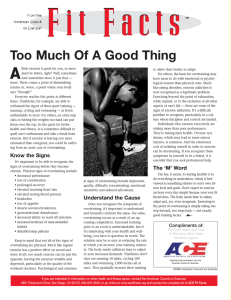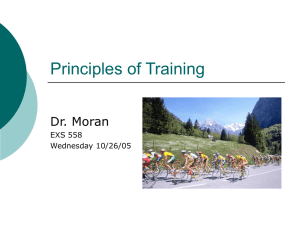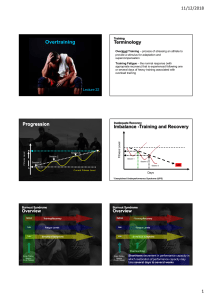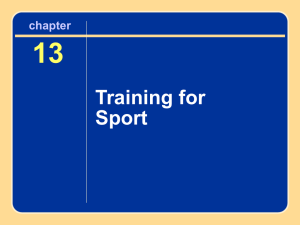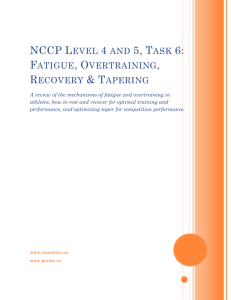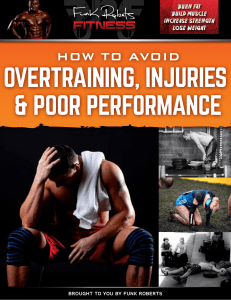Overtraining in the Female Athlete Jacalyn J. Robert-McComb, PhD, FACSM
advertisement
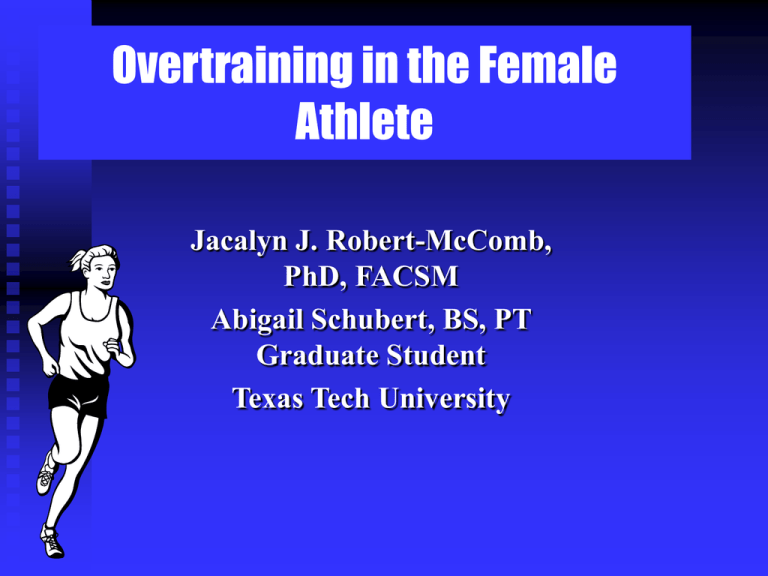
Overtraining in the Female Athlete Jacalyn J. Robert-McComb, PhD, FACSM Abigail Schubert, BS, PT Graduate Student Texas Tech University Learning Objectives • Define overtraining and staleness • Discuss various responses to overtraining and staleness: • Mood swings • Hormonal Responses • List signs of overtraining Introduction to the Overload Principle The body must be exposed to progressive amounts of overload in order to continue experiencing adaptations. When exposed to excessive physical stress the body may begin to exhibit signs of overtraining and/or staleness. Staleness vs. Overtraining • Overtraining- Typically short term, caused by an imbalance between training and recovery time. • Staleness- due to extended periods of overtraining. Has far greater consequences. • Both hinder athletic performance Short Term Overtraining • Also called over-reaching • Over-reaching refers to a brief period of heavy overload without adequate recovery. • Overreaching can actually contribute to enhanced performance since it usually lasts no more than two weeks. • Can easily be reversed with a few days of reduced training intensity/volume or complete rest. • Supercompensation can be achieve after overreaching within a few weeks of rest Staleness • • • • Also termed the overtraining syndrome Occurs after long periods of over-reaching Much more serious condition than over-reaching Causes fatigue and inability to complete workouts and competition at previous levels • The OTS is defined as persistent underperforming, with or without other accompanying psychological and physical symptoms, despite weeks of lighter training or complete rest . Types of Staleness Sympathetic -changes in the adrenal medullar response system -non-endurance type sports -high resting heart rate, decreased appetite and weight loss Parasympathetic -altered pituitary adrenal cortical response -low pulse, fatigue early in exercise, excessive sleep Profile of Mood States • Measurement used in studies to determine one’s mood profile • Rank moods such as anger, fatigue, confusion, depression, vigor and tension • Athletes tend to rank high in vigor and low in the other moods • However, overtrained athletes show higher scores in fatigue and depression Mood and Overtraining • Overtraining can lead to prolonged periods of depressed mood states coupled with fatigue. • This often leads to stress that further compounds the problem and hinders performance • Coaches should be aware of the mental states of their athletes in order to catch a problem before performance is affected Hormonal Responses to Overtraining and Staleness • Overtraining syndrome has thought to be diagnosed by the changes in the recovery phase of the plasma levels of certain hormones (epinephrine, norepinephrine, cortisol) • However, results have been inconsistent Hormonal Responses Cont. • Increments in plasma cortisol levels immediately after exercise have been found by some authors (Kuoppasaimi, Naveri, Harkonen, et al., 1980 , whereas others have found decrements in adrenocorticotropic hormone and cortisol responses in trained runners following a bolus of ovine corticotropin-releasing hormone (Luger, Duester, Kyle, et al., 1987). Overtraining in Athletes • Athletes that exceed 30 hrs of training a week are susceptible to staleness. • Most athletes experience overtraining at least once in their career . Signs and Symptoms of Overtraining • Alteration in physiological functions and adaptations to performance • Psychological symptoms • Immunological dysfunction • Biochemical alterations Source: Fry FW, Morton AR, Keast D. Overtraining in athletes: an update. Sports Med 1991;12:32-65. Alteration in Physiological Functions and Adaptations to Performance • Decreased performance • Decreased muscular strength • Muscle soreness and tenderness • Reduced tolerance of loading • Recovery prolonged • Chronic fatigue • Headache • Sleep-wake cycle abnormalities • Changes in blood pressure and heart rate • Alterations in sexual functions • Gastrointestinal disturbances Psychological Symptoms • • • • • • • Feelings of depression General apathy Difficulty in concentration Emotional instability Fear of competition Loss of appetite Excitation and restlessness Immunological Dysfunction • Increased susceptibility to bacterial infections • Reactivation of herpes viral infections • Decreased functional activity of neutrophils • Decreased total lymphocyte count • Decreased production and secretion of immunoglobulins Biochemical Alterations • Decreased hemoglobin, serum iron and ferritin • Negative nitrogen balance • Increased urea levels • Increased uric acid productions • Decreased glutamine concentration • Mineral depletion (Zn, Co, Al, Mn, SE, Cu, etc.) • Low free testosterone • Decreased free testosterone to cortisol ratio of more than 30% Conclusion Universally agreed diagnostic criteria for OTS are lacking Despite the research that has been conducted on the overtraining syndrome known as staleness, there is a vast body of knowledge still unknown to researchers concerning the extent of this malady. Conclusion cont’d • Diagnosis is difficult , overtraining can be confused with fatigue due to a hard workout or stress related symptoms, leading the athlete to become frustrated with their performance and push himself or herself even harder. • Consideration of symptoms in alerting the health care professional to overtraining in the athlete should be made in conjunction with the athlete’s own assessment of well-being .
